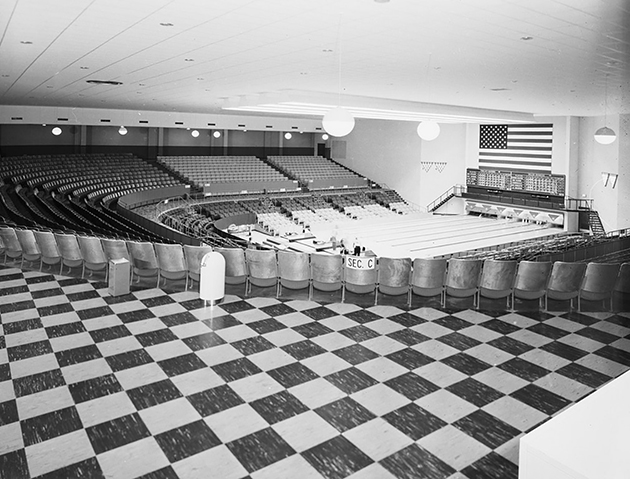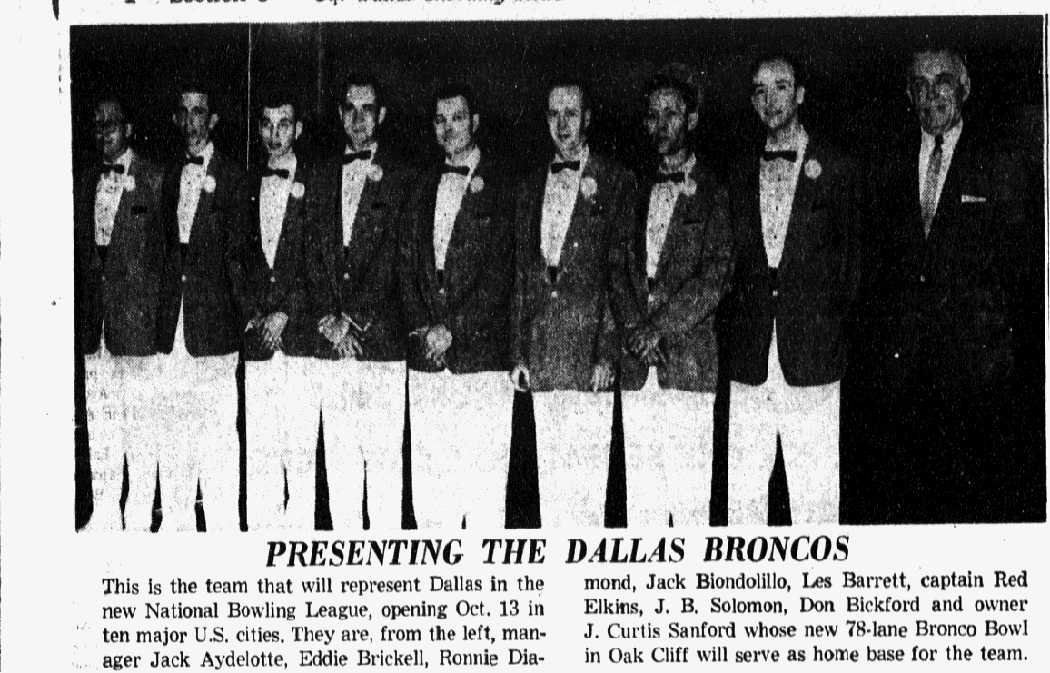
The Bronco Bowl’s six-lane arena, which was built on hopes for the televised National Bowling League. (Photo Courtesy Of The Texas/Dallas History And Archives Division, Dallas Public Library And The Dallas Morning News Historical Archives)
On a roll
Dallas oilman J. Curtis Sanford started the Cotton Bowl Classic football game in 1937, and it would become one of the most popular college bowl games of all time.
Sanford was 34 when the first Cotton Bowl game, between Texas Christian University and Marquette University, was played.
Toward the end of his life, Sanford took up another sport, bowling.
During the mid-20th century, bowling mania hit the United States middle class hard.
Bowling became one of the most popular pastimes in the nation, especially after the invention of automatic pinsetters.
Most Dallas companies had recreational bowling leagues for their employees. There were competitive high school and college leagues as well as minor league professionals. The daily newspapers ran scores, stats and news on local bowling leagues.
Sanford picked up on this trend in the early 1960s as a way to make money with recreational bowling alleys as well as through televised professional bowling via the National Bowling League.
The league formed in 1961, and the first match pitted the New York Gladiators against Sanford’s team, the Dallas Broncos. Among the pros on the Broncos team was Eddie Brickell, father of Oak Cliff native singer/songwriter Edie Brickell.

The Dallas Broncos lineup included Eddie Brickell, whose daughter, Edie, is the famous singer/songwriter. (Photo Courtesy Of The Texas/Dallas History And Archives Division, Dallas Public Library And The Dallas Morning News Historical Archives)
The match was televised at the Bronco Bowl in Oak Cliff.
Sanford poured millions of dollars into building the 78-lane Bronco Bowl on Fort Worth Avenue on the prospect that the National Bowling League could be a moneymaker.
He built it for $3 million on the site of the former Mustang Village federal housing project. It had 72 lanes for public bowling and a six-lane arena for televised professional bowling.
The 136,000-square-foot complex also included pool tables, indoor archery, a pinball arcade, slot-car racing, a miniature golf course, a concert hall, food concessions and a barbershop. Actress Jayne Mansfield, a Dallas native who once lived in Oak Cliff, appeared at the ribbon cutting.
When it opened, the Bronco Bowl set a record for having the largest “housewives league” in the nation with 72 teams. They rolled at 10 a.m. on Fridays — there was a free “nursery” for the littles.
The Bronco Bowl could seat 3,000 spectators, but on the Dallas Broncos’ opening night, in October 1961, just 2,000 bought tickets. It went downhill from there.
NBL teams began folding that December, and the league was down to a handful of teams the following spring. The league was dead by July 1962.
Sanford also had opened two other bowling alleys in 1961, Valwood Lanes in Farmers Branch and the Cotton Bowling Palace on Inwood Road at Lemmon Avenue.
All are gone now.
The Bronco Bowl lingered as a cavernous but underused bowling alley through the 1970s.
It was reconfigured in the 1980s as a concert venue. It also had 22 bowling lanes, a sports bar and three small clubs.
David Bowie, The Clash, Public Enemy, Bruce Springsteen, U2, Metallica, Pantera and Beck are among the many big names who performed there during its musical era.
The Bronco Bowl closed in 1991, but it reopened in 1996. The venue continued for several more years until Home Depot bought it in 2003 and tore the gathering spot down.




